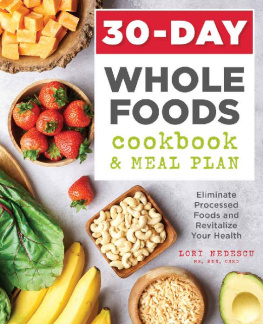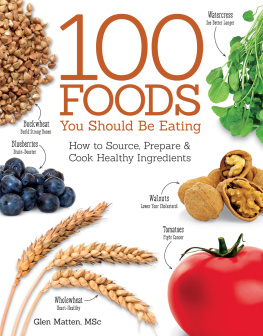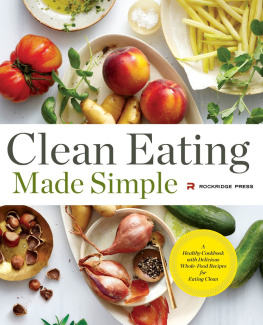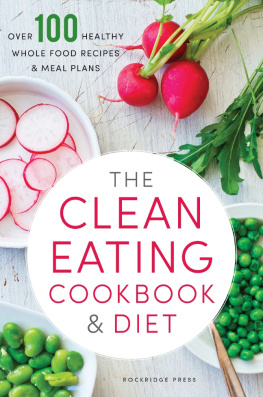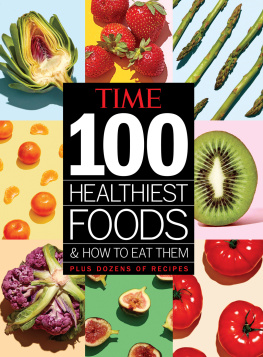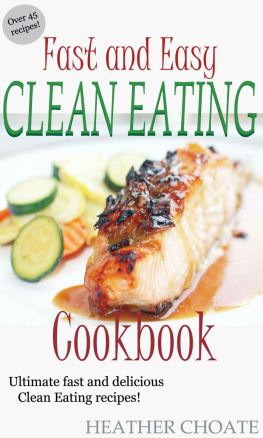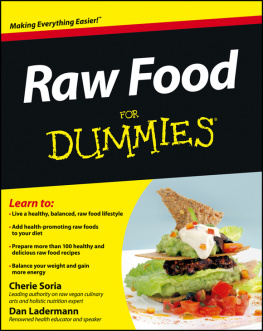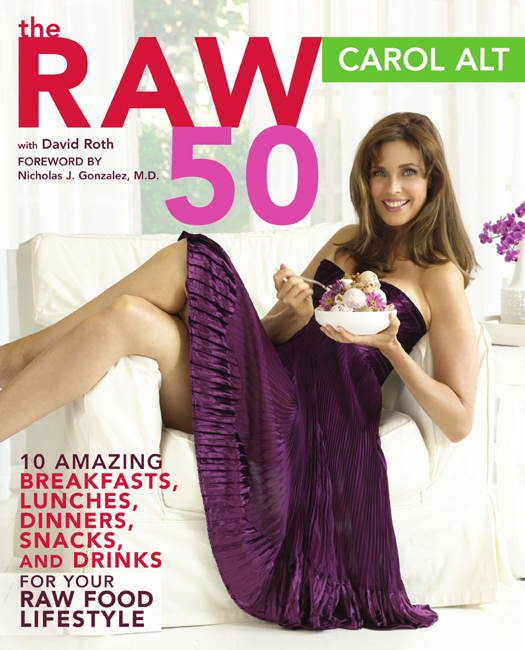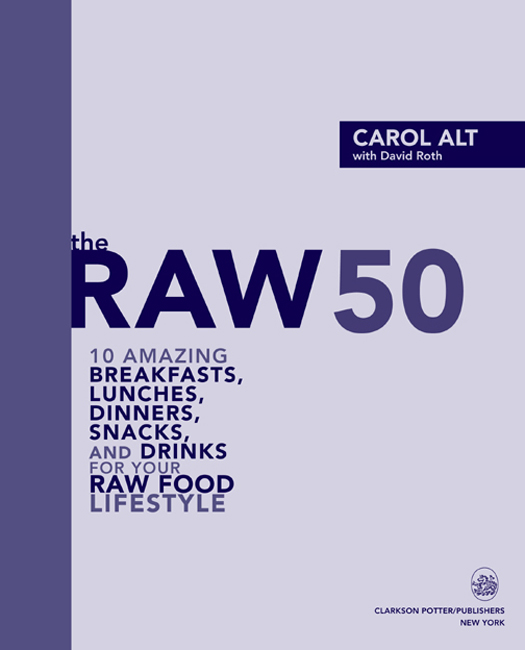Copyright 2007 by Carol Alt
Foreword copyright 2007 by Nicholas J. Gonzalez, M.D.
All rights reserved.
Published in the United States by Clarkson
Potter/Publishers, an imprint of the Crown
Publishing Group, a division of Random House, Inc.,
New York.
www.crownpublishing.com
www.clarksonpotter.com
Clarkson N. Potter is a trademark and Potter and
colophon are registered trademarks of Random House, Inc.
Library of Congress Cataloging-in-Publication Data
Alt, Carol,
The raw 50: 10 amazing breakfasts, lunches, dinners,
snacks, and drinks for your raw food lifestyle / Carol Alt
with David Roth.1st ed.
Includes index.
1. Raw food dietRecipes. I. Roth, David. II. Title.
III. Title: Raw fifty.
RM237.5.A467 2007
641.563dc22 2006039185
eISBN: 978-0-307-48999-9
v3.1
You have sown much, and bring in little; you eat, but do not have enough; you drink, but you are not filled with drink.
Haggai 1:6
FOREWORD BY NICHOLAS J. GONZALES, M.D.
When Carol Alts first book, Eating in the Raw, proved to be so well received, I couldnt have been more pleased. Ive been acquainted with Carol now for many years, and know how important it is to her to spread the word about good nutrition in general, and raw food in particular. Eating in the Raw did change lives, sometimes in very small ways, sometimes more profoundly. Since the book first came out, Carol has heard from many readers who reported that their health had been changed for the better by following some of the simple rules she outlined. Many wrote with gratitude that their energy had improved, their headaches had disappeared, the pounds had fallen away, the aches and pains had lessened, just by giving up the junkthe white flour, white bread, white sugar, the chemicals and the synthetics passed off as foodand instead turning to whole foods, clean foods, organic foods, and largely raw foods, with all the vital vitamins, minerals, and enzymes intact and untouched.
As she did with Eating in the Raw, Carol asked me if I would be willing to write the foreword to this new book. I was honored to do so. She and I continue to be eager to address the question were commonly asked by those new to the raw food lifestyle: Must I become a vegetarian to reap the benefits of this diet? The short answer is no; while some who go raw do ultimately forgo animal products, including dairy, it is an individual choice based on what combination of foods makes one feel best.
I am also asked why raw food is beneficial to our health. The first time I talked at some length about enzymes, those intricate protein catalysts that allow the complicated reactions of life to occur efficiently and rapidly. I also pointed out that food not only provides proteins, fats, carbs, along with the health-promoting vitamins, minerals, and trace elements, but actually represents an excellent, though usually unappreciated, source of enzymes. In general, we dont think of food as a source of enzymes, though in fact, all foodwhether animal or plant in origincan provide large quantities of these life-supporting proteins. We can absorb these food enzymes for use as replacements for our own damaged and aging cellular catalysts. But heres the catch: Food can provide these beneficial enzymes only if its raw.
In our office, my colleague Dr. Linda Isaacs and I dont recommend a single perfect diet that works for all. On the contrary, we prescribe a variety of diets for our patients, depending on individual metabolic needs. These can range from near vegetarian to largely red meat, with all variations in between. Such an approach, we realize, might be considered unusual, since in the nutritional world today, whether alternative or more conventional, dietary experts usually proclaim the value of one ideal diet. Too often, though, the perfect diet of one expert differs considerably from the perfect diet extolled by another, and the wars between the camps can become quite intense.
Many nutritional researchers maintain that all humans should eat vegetarian, or as close to vegetarian as possible. Such an approach reached full flower during the 1980s and 1990s, with the widely publicized dictates and popular books of vegetarian evangelists such as the late Nathan Pritikin, Dr. Dean Ornish, and those that promote the macrobiotic school of thought. All of these movements, though differing in the nuts-and-bolts specifics, subscribe to the belief that the less fat and the fewer animal products the better. For these thinkers and scientists, carbs are our true friend, the more the better, and animal fat and protein are the most insidious enemies, the obvious root cause of the epidemic obesity, diabetes, and heart disease afflicting most Western nations. Raw foods proponents such as the late Ann Wigmore, who for years ran a raw foods clinic in Boston, invariably tend toward the purely vegetarian: to these folks, raw means raw vegetarian, period.
On the other hand, there have been those, like the late Bob Atkins, as well as more conventional researchers such as Dr. Gerald Reaven from Stanford, who take the complete opposite tack. These physicians have warned and continue to warn that a high-carbohydrate, plant-based diet, particularly one heavy on refined sugar, refined white flour grains, synthetic trans-fats, and synthetic chemicals, is the true culprit behind obesity, diabetes, and heart diseasethe very same problems the vegetarians blame on fat. Small wonder the consumer looking for simple guides for better health can experience nothing but confusion.
I have long thought that much of the angry dietary discourse might be resolved if only nutritional researchers would consider for a moment where our various ancestors came from, and the type of food they would have eaten. Historically, our antecedents occupied a variety of ecological niches, each providing a different type of food, from the Arctic Circle to the Equatorial jungles of South America. The foods available in each of these places vary considerably, and for humans to have existed in these locales, they would of necessity have had to survive on very disparate diets.
In the Arctic regions of Canada, Alaska, Siberia, and Greenland, winter lasts much of the year. Such a clime allows for no real summer of any consequence, and certainly not the significant growing season needed to nurture and harvest the plant foods most familiar to us: fruits, vegetables, nuts, seeds, and grains. In the Arctic, other than a few varieties of berries, plant foods suitable for human consumption simply do not exist. The Arctic does, however, provide an abundant supply of fatty animals, like caribou and bear, fatty fish, and for those near the sea, ocean animals such as seal and whale.
At the turn of the last century, the explorer and anthropologist Vilhjalmur Stefansson spent ten years studying the Inuit (previously known as Eskimos), living among them as one of the community, at a time in history when these famed hunters still lived their traditional and very isolated life. He summed up his observations and experiences in a series of very popular books published during the first half of the 1900s.
During his stay in the Arctic, he was astonished to find that the Inuit he observed lived on an all-meat diet consisting of about 80 percent fata way of eating that experts even in Stefanssons day claimed could not support human life. But eat meat the Inuit did, to their apparent great benefit. As Stefansson reported in his book


